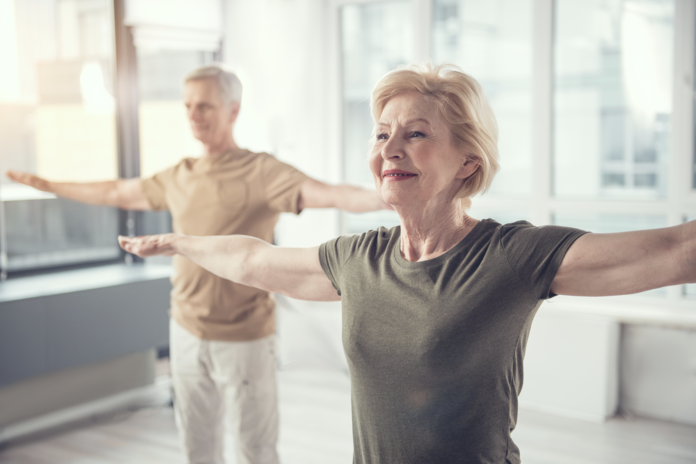Nowadays, how lifestyle factors like diet, exercise, sleep, and even core strength affect health is becoming more obvious. But proper posture? It is much less known how good posture affects health and longevity. Though, lo and behold, it certainly does!
Let this be a guide to the importance of proper posture and how to improve posture to facilitate optimal health, including good posture exercises to help.
What Is Posture?
What comes to mind when pondering posture? Likely, standing up straight or sitting in a chair takes the cake. However, it is a little more complicated than that.
Posture is the position in which one holds their body while standing, sitting, and lying. As an extension, good posture involves training the body to stand, sit, lie and walk so as to place the least amount of strain on muscles and ligaments, especially while moving or performing weight-bearing activities.
There are two types of posture including:
- Dynamic posture: how one holds themselves while moving, such as when walking, running, bending over, or lifting something.
- Static posture: how one holds themself when not moving, such as when standing, sitting or lying.
Both are important and tend to correlate with each other, meaning, good dynamic posture often equals better static posture and vise versa. The opposite is true as well. Poor posture in one area generally indicates poor posture in the other.
Proper Postures
Now, the key to good posture is spinal positioning. The spine has three natural curves at the neck, mid back and lower back. Correct posture will maintain these curves without over or under extending them. Additionally, the head should be above the shoulders and the top of shoulders directly over the hips. Yet, each posture position still holds some nuance.
Proper Sitting Posture
- With the buttocks touching the back of the chair or other sitting equipment, sit up with a straight back and shoulders slightly angled backwards.
- Distribute body weight evenly on both hips.
- Bend knees at a right angle and keep them even or slightly higher than the hips (may need a footstool), and avoid crossing legs.
- Keep feet flat on the floor or other raised device like a step stool.
Other tips:
- Avoid sitting in the same position for more than 30 minutes, or rather, get up and stretch or take a short walk every 30 minutes.
- At work or in an office, adjust the chair height and workstation so that you are not straining arms or shoulders, and rest elbows and arms on the chair or desk to keep shoulders relaxed.
- When sitting in a chair that rolls or pivots, twist the entire body and not just at the waist.
- When standing up from a chair, move to the front of the chair, stand up with the legs straight, and avoid bending forward at the waist.
- Use a back roll (lumbar roll) at the curve of the lower back if needed.
- When driving, move the seat close to the steering wheel to support the curve of the back.
Proper Standing Posture
- Stand up straight and tall.
- Keep shoulders slightly back.
- Pull the belly button to the spine.
- Put weight mostly on the balls of the feet.
- Keep the head level and look comfortably forward.
- Let arms hang down naturally at the sides.
- Keep feet about shoulder-width apart.
Proper Lying Posture
- Sleep in a position that maintains the curve of the back, which usually involves lying on the back.
- Consider putting a pillow under the knees or lower back for more benefit.
- Sleeping on the side with knees slightly bent but not curled to the chest is the next best position.
- Avoid sleeping on the stomach, especially on saggy mattresses, as this causes the most back strain.
Other tips:
- Select a firm mattress and box spring that does not sag.
- If necessary, place a board under the mattress to make it more firm.
- A rolled sheet or towel tied around the waist can mimic a lumbar support.
- When standing from the lying position, turn onto the side, draw up both knees and swing them to the side of the bed. Push yourself up with your hands and avoid bending forward at the waist.
Proper Lifting Posture
- Ensure you have firm footing, with feet shoulder-width apart.
- To pick up an object lower than the level of the waist, keep the back straight and bend at the knees and hips. Avoid bending at the waist with straight knees.
- Tighten stomach muscles and lift the object using leg muscles.
- Straighten knees in a steady motion and do not jerk the object.
- Stand completely upright without twisting and only move feet forward if needing to move it.
- If lifting an object from a table or similar surface, slide it to the edge of the surface and use legs to lift the object similarly to above.
- Hold the package close to the body with arms slightly bent, keeping core muscles tight.
- To lower an object, place feet shoulder-width apart, squeeze core muscles and bend at the knees and hips.
How Does Posture Affect Health?
Posture interestingly affects health in various ways but most of them deal with preventing pain and injury, especially in the neck, shoulder, back, hips and knees. However, proper posture also exerts a domino effect of sorts.
For example, poor sleeping posture can affect energy levels, which might affect motivation to exercise. Similarly, constantly poor sitting posture can lead to severe arthritis which can then lead to depression and/or decreased quality of life.
But without further ado, here are the main ways good posture directly affects health:
- Decreases strain placed on the spine.
- Prevents the spine from becoming fixed in abnormal positions (aka scoliosis).
- Keeps bones and joints in the correct position and alignment.
- Eases muscle, tendon, and ligament strain.
- Reduces the wear and tear of joint surfaces to help prevent conditions like arthritis.
- Prevents fatigue because muscles are working more efficiently rather than compensating.
- Prevents severe neck, shoulder, back, hip, knee and muscular pain.
- Maintains or improves flexibility.
- Promotes better balance and reduces risk of falls.
- Improves digestion and respiratory mechanics.
- Reduces risk of all injuries.
5 Exercises to Improve Posture
Luckily, there are many exercises that help promote better posture. Regularly adding these into a routine one to three times a week can drastically improve posture and help you avoid the consequences of poor posture.
At the very least, practicing good posture can offer a bit more height at the doctor’s office and mitigate or reverse arthritis pain on the other end of the spectrum.
1. Child’s Pose
This resting pose stretches and lengthens the spine, glutes, and hamstrings and helps to release tension in the neck and lower back.
Start by sitting on the shin bones with knees together, big toes touching, and heels splayed to the outside. Fold forward at the hips and place hands in front of you. Sink hips back down toward the feet. Place a pillow or folded blanket under thighs if they cannot go all the way down. Gently place the forehead on the floor or turn it to one side. Keep arms extended or rest them next to the body and breathe deeply into the back of the rib cage and waist.
Remain in this pose for 30 seconds to five minutes while breathing.
2. Forward Fold
This standing stretch releases tension in the spine, hamstrings, and glutes and stretches the hips and legs. Basically, it helps open and lengthen the entire backside of the body.
To do this pose, stand with big toes touching and heels slightly apart. Fold forward at the hips and release hands towards the floor or place them on a block. Go as far as you can if you cannot fully reach the floor. Bend knees slightly, soften the hip joints, and allow the spine to lengthen. Tuck the chin to the chest and allow the head to fall heavy towards the floor.
Remain in this pose for up to one minute and repeat up to three times in a row.
3. Downward Facing Dog
This forward bend position helps to relieve back pain and strengthens and aligns the back muscles.
To begin, lie with the stomach on the floor, and press into the hands while tucking toes under the feet and lifting the heels. Lift the knees and hips towards the ceiling and bend knees slightly to lengthen the spine. Keep ears in line with the upper arms or tuck chin into the chest. Press firmly into the ground with hands and keep heels slightly lifted.
Remain in this position for up to one minute and repeat up to three times in a row.
4. Thoracic Spine Rotation
This exercise not only relieves tightness and pain in the back but increases stability and mobility as well.
To execute, lay flat on the ground. Spread arms out horizontally, in line with the ears. Turn head to one side and twist legs at the hips to the opposite side as the head. Bend knees in a 90-degree position, with toes facing forward.
Hold this position up to one minute, breathing deeply the entire time before switching head and hips to the opposite sides.
5. High Plank
This rendition of the plank helps relieve pain and stiffness throughout the body and strengthens shoulders, glutes, and hamstrings. It can also help develop balance and strengthen the core and back.
To do this pose, come onto all fours and straighten legs, lift heels and raise hips. Straighten the back and engage the core, arm, and leg muscles. Focus on lengthening the back of the neck, softening the throat, and looking down at the floor. Keep the chest open and shoulders back.
Hold this position for 30 seconds to two minutes a time and repeat two to three times in a row if desired. This position can also be executed on each side for similar benefits.
Other exercises known to improve posture include cat cow, standing cat cow, chest opener, pigeon pose, glute squeezes, and isometric rows among still more.
Other General Ways to Improve Posture
Finally, there are a few general ways to facilitate good posture, including:
- Be mindful of posture during everyday activities.
- Stay active throughout the day to avoid remaining in one position for too long.
- Maintain a healthy weight, so as not to strain muscles, tendons and joints in general.
- Wear comfortable, low-heeled shoes as high heels unnecessarily strain posture.
- Work at comfortable heights whether sitting or standing.
- Take brief stretching breaks or walks if sitting for long periods of time.
- Always make sure feet touch the floor when sitting.
- Relax shoulders to relieve tension.
- Keep elbows close to the body at most times.
- Fully support the back at all times by using a pillow or other back support to mimic the lower back’s natural curve.
- Support hips and thighs with padded seats and keep them both parallel to the floor when sitting.
In Summary
While often overlooked, good posture can improve health for the better. Improve posture with a number of exercises, as well as paying attention to posture when sitting, standing, and lying down.
Especially if experiencing chronic pain and discomfort, seek out medical advice for individual care. They can help customize stretching and strengthening exercises to target personal needs.
References:
How to Improve Posture For a Healthy Back. Cleveland Clinic. Reviewed April 16, 2019. my.clevelandclinic.org/health/articles/4485-back-health-and-posture.
Cronkleton E. Posture Exercises: 12 Exercises to Improve Your Posture. Healthline. Updated May 29, 2020. www.healthline.com/health/posture-exercises.
Guide to Good Posture. MedlinePlus. U.S. National Library of Medicine. Updated April 22, 2021. medlineplus.gov/guidetogoodposture.html.






